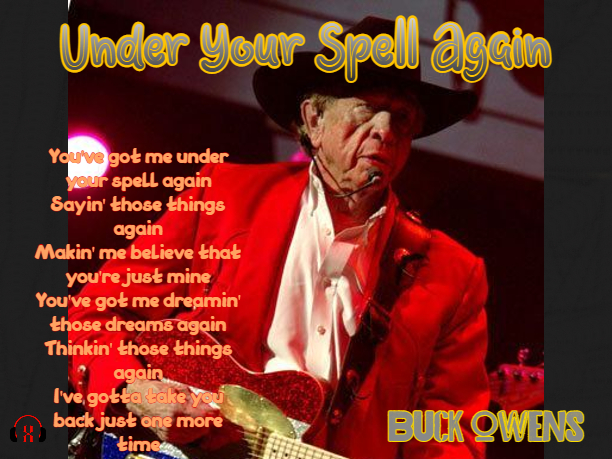![]()
Unveiling the Tale Behind Buck Owens’ “Together Again”
Prepare to be enthralled by the captivating story behind one of Buck Owens’ timeless classics, “Together Again.” This remarkable song has traversed genres and eras, leaving an indelible mark on the music industry. Let’s embark on a journey that uncovers the origins and evolution of this beloved melody, and the profound impact it has had on both the artist and his devoted fans.
The year 1963 marked a turning point in Buck Owens’ career. With the release of “Act Naturally,” his first chart-topping hit, followed swiftly by “Love’s Gonna Live Here,” a monumental record that dominated the country charts for 16 weeks, Buck skyrocketed to stardom. Hailing from the Bakersfield music scene, this 34-year-old sensation brought his distinctive California honky-tonk sound to Nashville, captivating audiences and controlling the charts with his magnetic presence.
Despite being associated with a West Coast label, Owens was actually born in Texas and had migrated to Arizona during the Great Depression. After dropping out of high school, he held various menial jobs before pursuing his musical ambitions. By the age of 21, he had honed his guitar skills and secured a position in a nightclub band.
In the mid-1950s, Owens found himself in the Capitol Records studios in Los Angeles as a session musician, lending his talent to esteemed artists like Tennessee Ernie Ford, Sonny James, Wanda Jackson, and Faron Young. Although Buck yearned to prove himself as a solo artist, the A&R staff at Capitol repeatedly rejected his vocal performances. However, an astute producer recognized Owens’ potential and advised him, “Owens, we’ve got plenty of singers, what we need are songs.”
This pivotal moment prompted Buck to venture into songwriting, in addition to his session work and live performances. By 1956, his compositions had captured the attention of Ken Nelson, the head of Capitol Records, who was impressed with Owens’ material. The following year, Nelson signed Buck to a recording contract. In October 1959, Owens achieved his first Billboard Top Five hit with “Under Your Spell Again.”
One of Buck’s defining qualities, which captivated Ken Nelson, was his unique musical style. Combining influences from Texas swing, cowboy music, and rockabilly, Owens forged a distinct sound that blended elements of these genres. His western honky-tonk vocal delivery possessed a melodious quality, setting him apart from Webb Pierce’s twang and Lefty Frizzell’s rawness. This amalgamation of influences gave birth to what would later be known as the “Bakersfield Sound,” serving as a foundation for the music of iconic artists such as Merle Haggard and Dwight Yoakam.
As a songwriter, Buck Owens possessed an unparalleled understanding of his own vocal strengths and limitations. Consequently, he crafted songs tailored specifically for his voice, resulting in only a handful of his hits being covered by other artists. Songs like “My Heart Skips a Beat,” featuring a joyous drumbeat and Don Rich’s harmonies, burst forth from the radio with infectious energy. Hits like “Love’s Gonna Live Here,” “I’ve Got a Tiger by the Tail,” “I Don’t Care (Just as Long as You Love Me),” and “Sam’s Place” emanated an unmistakable sense of joy, showcasing Buck’s ability to deliver feel-good music while reaping financial success.
However, one of Owens’ self-penned tunes, “Together Again,” revealed a deeper, more introspective side of the artist. Written in the early morning hours of 1963, Buck initially dismissed it as a throwaway piece, composed effortlessly in a matter of minutes. The song spoke of the bliss that accompanies the reunion of lost love, conveying a near-prayerful sentiment. Its haunting melody, seemingly better suited for heartbreak, paradoxically underscored the immense pain of losing someone dear while highlighting the sheer ecstasy of being reunited.
Buck relegated “Together Again” to the B-side of his high-energy hit “My Heart Skips a Beat.” Little did he anticipate the staggering success that awaited this ballad. Just a week after its release, on March 28, 1964, “Together Again” swiftly ascended the country singles chart, closely following its A-side counterpart. Notably, the song showcased Tom Brumley’s acclaimed steel guitar solo.
In a remarkable turn of events, “Together Again” dethroned “My Heart Skips a Beat” from the top spot on June 6th, becoming the first and only instance in country music history where the B-side of a record replaced the A-side at number one. After a two-week reign, “Together Again” relinquished its position, allowing “My Heart Skips a Beat” to reclaim the pinnacle for an additional four weeks, ultimately spending a total of seven weeks at number one.
Curiously, Buck Owens appeared somewhat ill at ease when performing “Together Again” live. His usually beaming face bore a tinge of discomfort, as if the profound earnestness of singing about love unsettled him. Consequently, he retired the song from his concert repertoire once the initial frenzy surrounding it waned. However, renowned musician Ray Charles recorded his own rendition of “Together Again” on the pop side a couple of years later, which entered the Top 20 charts.
In 1976, Emmylou Harris, who had once opened for rock legend Gram Parsons, embarked on a quest for a song that would propel her to the summit of the country charts. While based in California and signed to a West Coast label, Harris felt a deep connection to Nashville, considering it her true musical home. Possessing one of the purest voices in the industry, Emmylou’s rock background and West Coast roots initially labeled her an outsider in the country music community. However, a conversation with her late mentor, Gram Parsons, sparked a transformative realization. Parsons emphasized the primary role of a song’s message in country music, as opposed to rock, where it often took a secondary position.
Immersing herself in the world of country music, Emmylou discovered the timeless beauty of “Together Again” and recognized its potential to resonate with a broader audience. She believed that her powerful voice could infuse the song with an additional layer of emotional depth. In the recording studio, Harris painted a magnificent portrait, using her rich country phrasing to breathe new life into the words and soaring melody.
Released by Reprise Records, helmed by the legendary Frank Sinatra, Emmylou’s rendition of “Together Again” surged up the charts in early 1976, reaching number one in April. This breakthrough marked Harris’ first chart-topping hit and laid the groundwork for a remarkable career that yielded 26 Top Ten hits on the Billboard charts, including seven number ones.
Emmylou felt as though “Together Again” had been tailored exclusively for her, and even Buck Owens himself came to acknowledge its profound impact upon hearing Harris’ version. He adored her rendition, which finally revealed the true power of his composition. Deeply moved, Buck reintroduced “Together Again” into his concert performances.
Three years later, Owens and Harris joined forces to release an updated duet version of the song, titled “Play Together Again, Again,” which peaked at number 11 on the charts. In 1979, Kenny Rogers and Dottie West recorded a duet version of “Together Again” for their “Classics” album, but it was not released until five years later on Kenny’s “Duets” album, reaching number 19 on the spring charts of 1984. Furthermore, in 2013, Vince Gill offered his own rendition of the song, featuring the masterful steel guitar work of Paul Franklin, on his critically acclaimed album “Bakersfield.”
Despite his undeniable impact on the country music scene, Buck Owens’ contributions have sometimes been overlooked. While boasting an impressive 21 number one hits and a remarkable 82 weeks atop the charts, he hasn’t always received the recognition he deserves. Perhaps his lighthearted persona on the “Hee Haw” television series played a part in this oversight. However, as an artist and songwriter, Owens stands tall among the greats. He not only pioneered a wildly successful sound, known as the “Bakersfield Sound,” but also introduced country music to countless new fans. Buck’s genuine approach and infectious smile endeared him to millions. Yet, his most enduring and impressive work might have been the song he initially dismissed. “Together Again” has become an indelible classic, even surpassing Owens’ own expectations, and it serves as a lasting testament to the genius of this remarkable artist.
Artist: Buck Owens
Lyrics
Together again
My tears have stopped falling
The long lonely nights
Are now at an end
The key to my heart
You hold in your hand
And nothing else matters
We’re together again
Together again
The gray skies are gone
You’re back in my arms
Now where you belong
The love that I knew
Is living again
And nothing else matters
We’re together again
And nothing else matters
We’re together again








